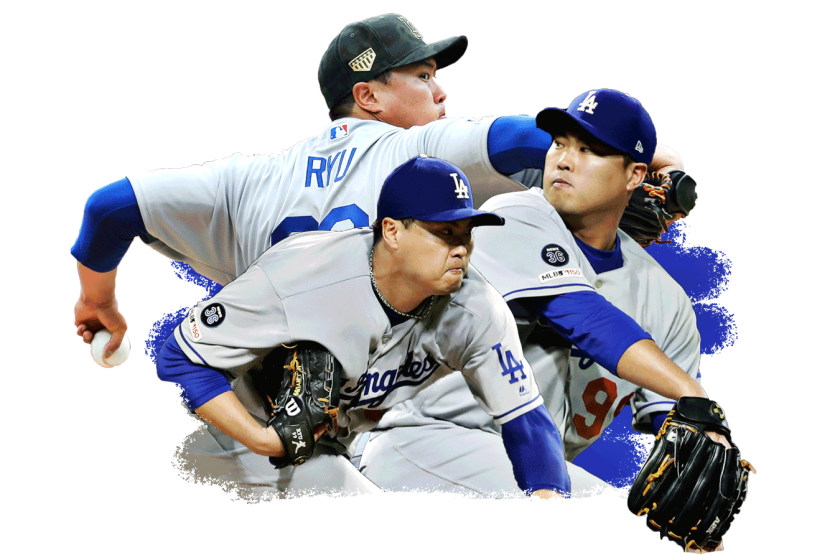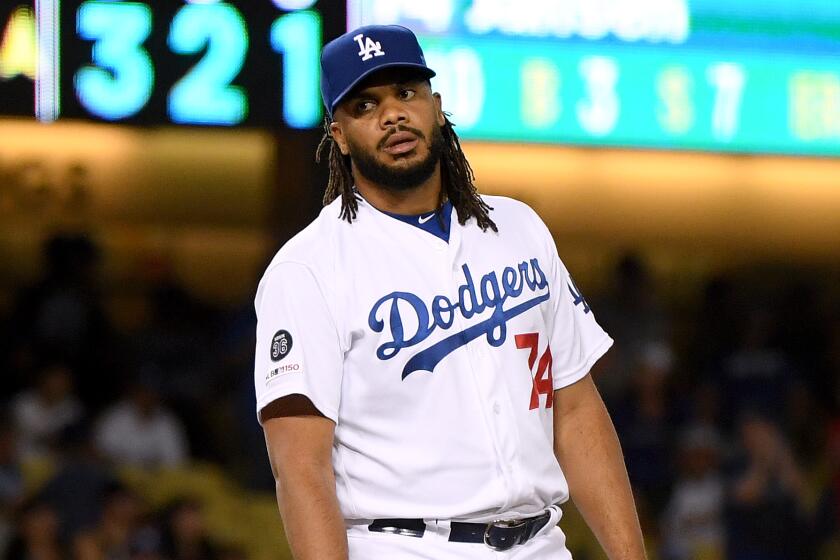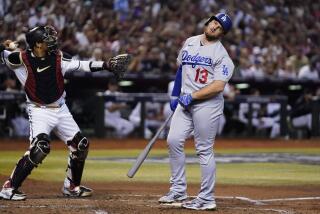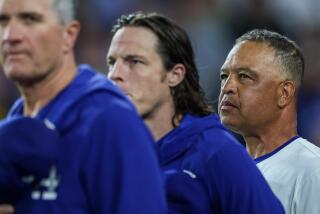Virtual reality batting practice head-set is Dodgers’ real-life preparation tool
- Share via
Matt Beaty had seen it before. The floppy blond hair. The low leg kick. The towering overhead release point. The blistering sinker with late, devastating bite.
Beaty had never faced Noah Syndergaard before the Dodgers’ game against the New York Mets on May 29. But thanks to the newest hitting tool at the Dodgers’ disposal, the rookie already had a feel for Syndergaard’s stuff. When he stepped to the plate, he knew what to expect.
Beaty is among a growing contingent of Dodgers embracing virtual reality batting practice, a cutting-edge device that uses a VR headset to create immersive visual experiences and simulate at-bats against opposing pitchers.
The release point, velocity and movement of pitches thrown by any MLB pitcher against the backdrop of any stadium can be summoned with a few keystrokes and observed through the headset. Batters can hold a miniature bat with a toggle they press to indicate when they’d begin a swing, or they can merely watch the computer-generated pitches.
Like learning the litany of features on a new smartphone, the Dodgers — who are fully implementing the device for the first time this season — have explored the best way to incorporate the VR system, which is manufactured by WIN Reality and used by nine or so teams. For a club hoping to finally win a World Series after back-to-back National League pennants, the technological toy has become a new tactic for improvement.
“It just adds to the familiarity [at the plate],” manager Dave Roberts said. “It’s not really taking the swing, it’s just more seeing where the ball comes out of, the flight, the lane the ball is getting to home plate.”
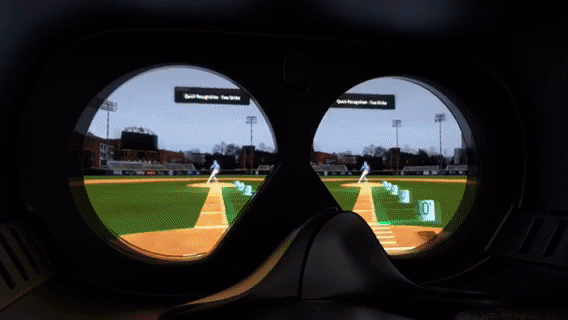
VR batting practice isn’t universally accepted, nor uniformly utilized in the Dodgers clubhouse. Some players, such as Corey Seager and A.J. Pollock, have integrated it into their preparation regimen. Others decline to use it altogether. Most fall somewhere in the middle, keen to see specific pitchers but hesitant to become completely reliant on the cutting-edge system.
“There’s never a big line to get in there,” Beaty said. “But I think a lot of guys like it.”
Before facing Syndergaard for the first time, Beaty slipped on the bulky headgear — which is housed in its own 12-by-15 foot space adjacent to the Dodgers’ weight room and can be packed up and taken on the road — and previewed the 6-foot-6 right-hander’s overpowering arsenal.
The exercise set Beaty up for success in the game. He pulled the first pitch he saw, an up-and-in 100-mph fastball, down the right-field line for an RBI double. In his second at-bat, he turned another high four-seamer into a single.
“Just seeing how his heater moved, obviously that was really hard,” Beaty said. “Just picking it up, seeing it [in the VR session beforehand], it was pretty accurate.”
This was the vision Chris O’Dowd, a former minor league catcher, had in mind when he co-founded WIN Reality with his father Dan, the former general manager of the Colorado Rockies who now is a studio analyst for MLB Network. They recognized a market inefficiency: that for all the “time and effort put into the swing, currently it’s really difficult to practice [a hitting] approach before a game,” Chris O’Dowd said.
Their VR batting practice system was designed to fill that vacuum. It combines data-driven models, actual video and computer-generated images to create a near-lifelike simulation inside the goggles.
“The idea that [hitters] can get 10 at-bats against us before they get in the box for the day feels like an advantage for them,” Dodgers pitcher Ross Stripling said with a wry smile. “It looks like a video game — but a really good video game.”
For all its potential, the system is largely a supplementary tool. But even the occasional five-minute VR session, O’Dowd believes, could have positive effects at the plate. A batter might more easily recognize a pitch sailing out of the zone, better square up something over the plate, or simply feel more comfortable facing an unfamiliar foe.
”I don’t think there’s a right way, an optimized way” to use it, O’Dowd said. “It’s more about: What is the specific player looking to take away from the experience?”
In the months since the system was installed in the Dodgers’ clubhouse, players have been trying to figure that out.
Justin Turner used the goggles four times to prepare for different pitchers, but went hitless on each occasion. Alex Verdugo and Joc Pederson occasionally use the VR system, but are still partial to traditional video study. Russell Martin recognizes its potential, but thinks the visuals could be better.
“I like the fact that it can help with your timing and give you a little bit of feedback on what the pitcher’s pitches are doing,” Martin said. But “you’re not seeing a real baseball. It’s like a dot. I’d really like to see the seams and the rotation of the ball.”
Nonetheless, some players experience benefitsfrom repeated use. Seager frequented the VR room during his near-month-long stint on the injured list earlier this season to keep his instincts and timing sharp. Pollock has also spent extended time in the virtual world, helping him overcome his own early injuries and spark his second-half hot streak.
“It’s a juiced way to watch a pitcher,” Pollock said. “It gives you a different perspective, to get in there and figure a couple things out that you might have not realized before. Because now, you’re getting more realistic reps.”
Can the Dodgers continue their winning ways without utilizing closer Kenley Jansen and his recent struggles?
That’s validation enough for the Dodgers. The technology is new, and to many players foreign. It’s a long way from reinventing the game. But by marrying baseball’s data revolution with the latest technological innovations, VR batting practice has already established its short-term impact. At the very least, it might be one more way for the Dodgers to tilt their World Series fortunes.
“Getting timing down, seeing the ball coming at you,” Beaty said. “I don’t think it can hurt.”
More to Read
Are you a true-blue fan?
Get our Dodgers Dugout newsletter for insights, news and much more.
You may occasionally receive promotional content from the Los Angeles Times.

